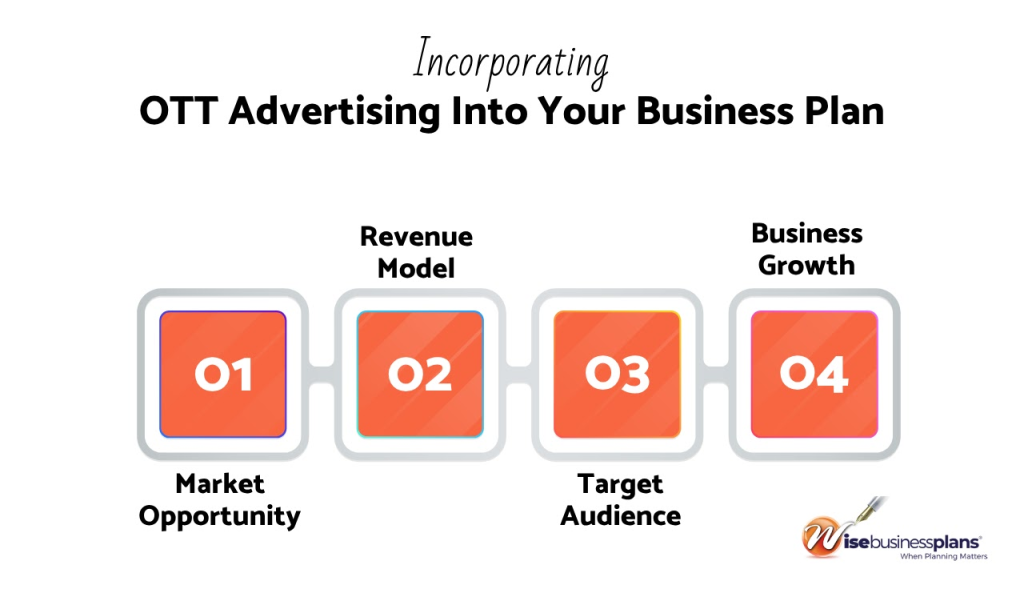How OTT Advertising Can Enhance Your Business Plan: A Guide for Entrepreneurs and Startups
Table of Contents
- What is OTT Advertising?
- OTT Advertising Platforms and Business Strategy
- Understanding OTT Advertising Formats
- Incorporating OTT Advertising Into Your Business Plan
- Optimizing OTT Advertising with Market Research
- Financial Projections: Monetizing OTT Content
- The Role of OTT Advertising in Business Growth
- Conclusion
- FAQ
The world of Over-the-Top (OTT) advertising is evolving rapidly, offering businesses powerful opportunities to reach target audiences through streaming platforms like Netflix, YouTube, and Hulu. While OTT advertising has traditionally been associated with entertainment and media companies, it is increasingly becoming an essential tool for businesses across various industries to engage customers, increase brand visibility, and grow revenue.
For entrepreneurs and small businesses, understanding how OTT advertising fits into the broader strategy is essential for success. With streaming services growing in popularity, integrating OTT advertising platforms can expand reach and boost engagement. This article explores how to incorporate OTT advertising into your marketing, measure its impact, and include it in financial projections—key steps for attracting investors and driving growth.
What is OTT Advertising?

OTT (Over-the-Top) advertising refers to delivering video content directly to consumers via the internet, bypassing traditional cable or satellite TV. OTT platforms like Netflix, Hulu, YouTube, and others allow viewers to stream their favorite movies, TV shows, and videos on-demand. In the context of advertising, OTT offers businesses a powerful way to reach their target audience through ads placed on these streaming services, capitalizing on the rich data and personalization capabilities that OTT platforms provide.
OTT Advertising Platforms and Business Strategy
In the digital age, OTT advertising offers businesses a unique opportunity to reach consumers directly through streaming services. OTT platforms like Netflix, YouTube, and Hulu allow users to stream content via the internet, bypassing traditional TV networks, making it a more flexible and scalable option for advertisers.
OTT advertising extends far beyond the entertainment sector. E-commerce businesses, education providers, retailers, and even healthcare services can leverage OTT to target highly engaged audiences with personalized content.
Integrating OTT advertising into your business strategy can help achieve:
- Brand Visibility: Reach a wide audience across various platforms, including smart TVs, mobile apps, and desktops.
- Targeted Marketing: Leverage demographic and behavioral data to target specific audience segments more effectively.
- Scalability: OTT advertising can grow alongside your business, with the ability to scale campaigns as your company expands.
Understanding OTT Advertising Formats
OTT advertising offers several models, each suited to different business goals. Choosing the right model for your business will shape both your marketing strategy and financial projections. Here are the main OTT advertising models:
SVOD (Subscription Video on Demand)
Businesses that offer exclusive, subscription-based content, such as Netflix or Disney+, can rely on SVOD to generate recurring revenue. If your business operates a subscription-based model, forecast subscription growth over time and estimate monthly or yearly revenue from subscribers. For example, you might offer multiple pricing tiers or exclusive content to encourage sign-ups and increase retention.
TVOD (Transactional Video on Demand)
Businesses offering premium content (like movies, shows, or specialized courses) can use TVOD to allow customers to pay for access to individual pieces of content. This model is ideal for businesses with unique or niche offerings, where one-time purchases are more appealing than a subscription.
AVOD (Advertising Video on Demand)
AVOD allows businesses to offer free content in exchange for ads, similar to platforms like YouTube or Hulu’s ad-supported tiers. For startups and small businesses, AVOD can be a great way to monetize content while building an audience. Advertisers pay based on impressions, and your revenue will depend on the size and engagement level of your audience.
Each model provides a different way to monetize content, and understanding these options will help you structure your revenue model and financial projections accordingly.
Incorporating OTT Advertising Into Your Business Plan
When preparing your business plan—whether to attract investors, secure funding, or guide long-term growth—integrating OTT advertising as part of your marketing strategy is crucial. Here’s how to include OTT advertising in key sections of your business plan:

- Market Opportunity: Highlight the growing shift from traditional TV to OTT platforms. More consumers are abandoning cable and satellite TV in favor of internet-based streaming services. Show potential investors the opportunity for your business to capture a share of this audience.
- Revenue Model: Detail how your business will monetize content or access revenue from advertisers. Whether through SVOD, TVOD, or AVOD, clearly outline how each model will contribute to your business’s revenue stream.
- Target Audience: Use audience data from OTT platforms to define your target market. OTT services provide detailed demographic insights (e.g., age, location, device usage) that can help you tailor your message. This precision is valuable when presenting your target market to potential investors.
- Business Growth: Explain how OTT advertising will help scale your business. As OTT platforms continue to gain traction, your business can increase its marketing budget, expand its reach, and tap into new customer bases.
Incorporating OTT advertising into your business plan demonstrates a forward-thinking approach and shows investors that you are leveraging modern technology to drive growth.
Thinking of writing a business plan?
Hire our professional business plan writers now!
Optimizing OTT Advertising with Market Research

To maximize the effectiveness of your OTT advertising, market research is essential. OTT platforms offer detailed data on user demographics, viewing habits, and device preferences. This information allows you to:
- Refine Targeting: Use demographic and behavioral insights to narrow down your audience and create more relevant, engaging ads. For instance, if your business targets young professionals, you could tailor your ads to be shown on mobile devices during evening hours when this group is more likely to be watching.
- Enhance Engagement: Analyze which types of ads resonate best with different audience segments. Some audiences may prefer short, snappy ads, while others may engage more with longer-form content. This data helps you tailor your approach to increase interaction and conversions.
- Adjust Strategies: Continuously analyze campaign performance and adjust your strategies to improve results. OTT platforms provide real-time data, allowing you to test different creative approaches and optimize for better outcomes.
By demonstrating your ability to use market research effectively, you can show potential investors that your marketing strategy is data-driven and capable of delivering measurable results.
Financial Projections: Monetizing OTT Content
Financial projections are a critical section of any business plan. Investors will want to understand how OTT advertising fits into your revenue model and how you plan to monetize content. Here’s how to incorporate OTT revenue streams into your financial forecasts:
- Revenue from SVOD: If your business operates a subscription model, forecast subscription growth and calculate expected monthly or yearly revenue. Consider offering multiple pricing tiers or exclusive content to increase subscriber numbers.
- Revenue from TVOD: Estimate income from individual content purchases or rentals. This can vary depending on the popularity of your content, pricing strategies, and customer preferences.
- Revenue from AVOD: If using an advertising-supported model, outline your strategy for attracting advertisers and estimate potential ad revenue. You can calculate potential earnings by estimating your audience size and using CPM (cost per thousand impressions) rates.
Including these revenue streams in your financial projections will help investors understand how OTT advertising will contribute to the scalability and profitability of your business.
The Role of OTT Advertising in Business Growth
As your business grows, OTT advertising can become a key component of your growth strategy. By leveraging OTT platforms, you can:
- Scale Your Reach: Use OTT advertising to extend your reach into new markets. Whether through national campaigns or localized, targeted ads, OTT allows you to advertise across diverse demographics with precision.
- Diversify Marketing Efforts: OTT complements other digital marketing strategies, such as social media ads, SEO, and email marketing, creating a multifaceted approach to customer acquisition.
Create - Personalized Experiences: OTT platforms enable highly personalized advertising based on viewer preferences and behavior. By delivering tailored content, businesses can increase customer engagement and improve conversion rates.
For businesses aiming to scale, OTT advertising offers the tools needed to grow a brand, engage customers, and generate new revenue streams—all of which are essential when planning for long-term success.
Ready to boost your business Checkout our free business plan examples now!
Conclusion
OTT advertising is not just a tool for large media companies—it’s an invaluable resource for businesses of all sizes. By integrating OTT into your business strategy, leveraging market research, and forecasting revenue through SVOD, TVOD, or AVOD, your business can enhance its marketing efforts, scale its reach, and build a solid business plan for sustainable growth.
As more consumers shift from traditional TV to streaming services, businesses that embrace OTT advertising will be well-positioned to engage a wider audience, increase brand visibility, and drive profitability. For entrepreneurs and startups, adopting OTT is not merely an option—it’s a powerful way to gain a competitive edge in today’s digital landscape.
FAQ
What does OTT advertising mean?
OTT (Over-the-Top) advertising delivers video content via the internet, bypassing traditional TV networks. It allows businesses to advertise on platforms like Netflix, YouTube, and Hulu, targeting specific audiences based on data.
How does OTT advertising work?
OTT advertising works by placing ads on streaming platforms, where viewer data helps target ads to specific demographics. Advertisers can choose from formats like pre-roll, mid-roll, and display ads.
What are the different OTT advertising models?
The three main OTT models are:
- SVOD: Revenue from subscriptions.
- TVOD: Pay-per-view or transactional content.
- AVOD: Free content supported by ads.
Why should my business use OTT advertising?
OTT advertising helps reach highly engaged viewers with targeted, personalized ads. It’s scalable and cost-effective, allowing businesses to grow their brand and increase revenue over time.
How can I measure the effectiveness of my OTT advertising campaigns?
Measure OTT campaign success by tracking metrics like view-through rates, click-through rates, conversions, and engagement. Real-time data helps adjust campaigns for better performance.













